Are you a Quiet Speculation member?
If not, now is a perfect time to join up! Our powerful tools, breaking-news analysis, and exclusive Discord channel will make sure you stay up to date and ahead of the curve.
In Modern Sleepers (Part 1), I led with a blurb about what makes Modern such a great format. Today, I’ll begin with a bit about what makes a card playable in Modern and how to hone card analysis skills.
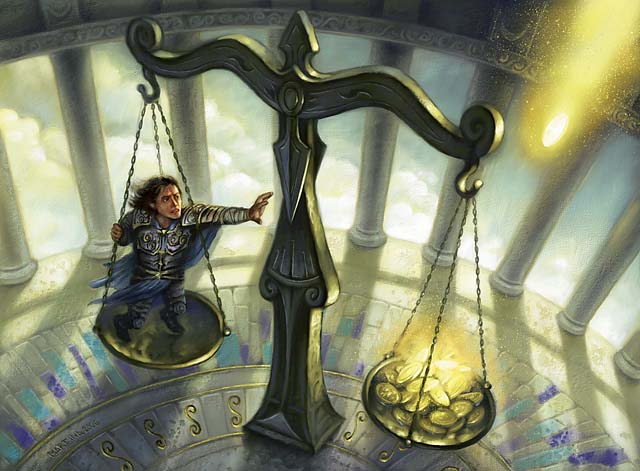
Improving at card analysis benefits players and collectors alike. When a budget player “buys in” on a card he can tell has potential, before others come to the same conclusion, he gives himself a larger budget to play and build with. Consider Hangarback Walker. The innocuous Origins artifact, which presold for less than a dollar, has now climbed past the $10 mark. Somewhere, a smart trader who spent just $15 on these is already looking at a shiny new Tarmogoyf (or maybe a beat-up Future Sight Tarmogoyf whose owner traded a set of Ice Age Brainstorms for the Lhurgoyf before it made its own splash in Standard).
[wp_ad_camp_1]
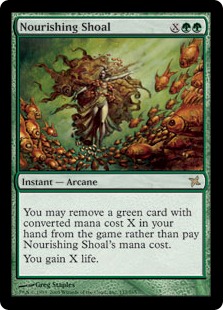 To some Modern players, money is no object, but detecting a card’s power also has competitive applications: it gives Spikes an opportunity to take events by storm with their new tech. Understanding what makes the card in question usable in Modern helps these Spikes build optimal piles. I’ve heard a few players dismiss this recent Modern Affinity list, which runs four mainboard Day's Undoings, as lucky and bad, saying they’d rather have Thoughtcast or other colored spells in Undoing’s slot. These critics don’t grasp the role Undoing plays in the deck, and that misunderstanding exposes their weakness at card analysis. Trevor Holmes’s recent article on Jace, Vryn’s Prodigy, and mine on Day’s Undoing, aim to describe the thought processes behind our faith in these cards, hopefully helping readers become better at judging cards themselves.
To some Modern players, money is no object, but detecting a card’s power also has competitive applications: it gives Spikes an opportunity to take events by storm with their new tech. Understanding what makes the card in question usable in Modern helps these Spikes build optimal piles. I’ve heard a few players dismiss this recent Modern Affinity list, which runs four mainboard Day's Undoings, as lucky and bad, saying they’d rather have Thoughtcast or other colored spells in Undoing’s slot. These critics don’t grasp the role Undoing plays in the deck, and that misunderstanding exposes their weakness at card analysis. Trevor Holmes’s recent article on Jace, Vryn’s Prodigy, and mine on Day’s Undoing, aim to describe the thought processes behind our faith in these cards, hopefully helping readers become better at judging cards themselves.
Since all cards are different, and all cases vary, I’ll leave readers with a general investment tip. If a card does something no other card does for the mana cost, and has an effect that could be relevant in a Modern metagame, it’s a fine spec. Nourishing Shoal is a good example of a card that fits into these parameters – it gains life for as low as 0 mana, and Burn is enough of a presence in Modern that lifegain will always hold some relevance. Feed the Clan is another – no other card gains up to 10 life for just two mana. Foil Feeds were priced under 50 cents each for months, and now cost over $7. Properly speculating on cards like these helps players expand their personal collections and stay one stop ahead of the metagame.
Five More Modern Sleepers
1. Huntmaster of the Fells
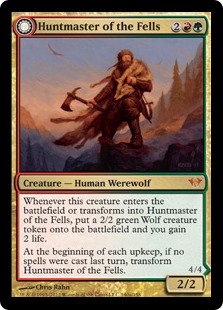
In his Origins review, Sheridan called out Pia and Kiran Nalaar as a potential Modern playable, citing its similarities to Huntmaster of the Fells and perceived aggressive benefits over the transforming Werewolf. The card has yet to make any waves, while Huntmaster remains a Jund staple. How come?
Huntmaster’s main benefit over the Origins newcomer is its nonreliance on mana. Post-resolution, he never asks players to spend more than their initial 2GR investment. Additionally, flipping Huntmaster back and forth in Modern is easy enough that, mana aside, I’d actually consider him more aggressive than Pia and Kiran. Against an answerless opponent, he deals 8 damage after resolving, 6 the turn after, and 10 the next, rivaling even Geist of Saint Traft in terms of pure aggression-for-cost. Being on-color with Blood Moon, not to mention on-curve, also helps lock opponents out of their answers before the beatings begin.
Another plus for Huntmaster is his ability to entirely take over a game. Modern has some 3 CC permanents with the same claim to fame, like Vedalken Shackles and Liliana of the Veil, but their costs make them susceptible to Abrupt Decay. At 4 CC, only Olivia Voldaren can hope to control a game alone, but her weak stats and continued mana requirement make her much easier to stop and pretty embarrassing against an onslaught of low-curve attackers. Bolting a resolved Olivia gives red mages a huge tempo boost, and with Lightning Bolt occupying four slots in 48% of all Modern decks, Huntmaster starts to look a lot more attractive. He also gets around bounce effects like Cryptic Command or Vapor Snag with his ETB ability, while these spells single-handedly reset any advantage gained by Olivia.
The goods Huntmaster provides upon entering the battlefield are only matched by Siege Rhino. Like the trampling 4/5, he generates value on multiple axes. Rhino gains life and deals damage, while Huntmaster gains life and provides a body. Pia and Kiran charge mana for anything in excess of the bodies they make, and even then, they only ever deal damage. Siege Rhino generally does a better job of stabilizing the board and redefining a damage race, but unlike Huntmaster, it never grinds opponents out on its own. It’s also harder to splash.
Fits into:
- Fair Gx decks that could easily splash for Lightning Bolt or Blood Moon (Mono Green Stompy, Devotion).
- Decks in GR that need a hand against other fair strategies.
- Decks in GR that reliably hit four mana in games against aggressive decks.
2. Gitaxian Probe
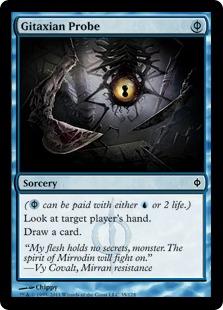
Probe does some things unconditionally and others situationally. It always provides perfect hand information and some non-negligible degree of deckbuilding consistency (as per Alan Comer’s Turbo Xerox principle). Many decks benefit greatly from information, a statement endorsed by Jund’s rich history of tearing opponents to shreds after an early Inquisition of Kozilek. As for consistency, shaving lands for spells has always benefited decks that can swing it, since it prevents mana flooding for a minimal cost.
Onto Probe’s situational value. Casting one with Young Pyromancer on the board makes a token, and revealing one to Delver of Secrets makes a flying, blue Wild Nacatl. Probe fills the graveyard for splashy Delve spells like Tasigur, the Golden Fang, and squeezes value out of an early Snapcaster Mage. Some decks (i.e. Grixis Delver) frequently encounter many of these Probe-friendly situations, making the card a natural fit there.
As of today, Gitaxian Probe sees play at an average of 3.9 copies per deck, in an average of 32% of all Legacy decks. By any metric, the card is undoubtedly a Legacy staple. So why doesn’t the card see much play in Modern? For one, Probe plays especially nicely with cards we don’t have. Many of Magic’s best consistency tools (Preordain, Sensei's Divining Top, Green Sun's Zenith) are banned in Modern. With these tools legal, players have extra decisions to make, and Gitaxian Probe helps make these decisions. Without dedicated consistency effects, many Modern decks aim simply to “play on-curve,” casting whatever spell taps all their lands. With their play choices already limited, the knowledge gained from Probe becomes less valuable.
But the main factor keeping Probe out of Modern is the format’s elephant-in-the-room orbit around Burn. In Legacy, Burn hardly ever makes it to the top tables, but its Modern iteration is one of the most consistent and powerful decks around. With great strength comes great representation, and Burn currently holds an impressive 8.3% share of the format. Obviously, Gitaxian Probe seems silly in a room full of Lava Spikes.
That said, I don’t think the card sees enough play. I’ve tuned even four-color decks to have favorable matchups against Burn with Gitaxian Probe in the mainboard. If a deck can make extra use of the information, consistency, stocked graveyard, or Instant/Sorcery density Probe provides, and it doesn’t have a terrible Burn matchup, I think it deserves a few copies.
Fits into:
- All tempo and combo decks with a decent plan against Burn (Delver, RUG Twin, Amulet).
- Linear aggressive decks that generally decide the pace of a game with their own speed (Infect, Suicide Zoo).
- Blue decks that have many decisions to make and can gain value from Probe in some other way (Grixis Control, UWR).
3. Grisly Salvage

Some consistency tools offer card selection universal enough to homogenize Modern decks. Supporting this claim, a quick look at the decks played while these cards were legal reveals that many lists started with 4 Ponder, 4 Preordain. Grisly Salvage provides a powerful consistency effect that only benefits certain strategies, but with the host of graveyard-related goodies playable in Modern, even decks other than Dredgevine stand to make great use of the card.
Fits into:
- Decks that benefit greatly from finding a specific threat.
- Decks that already rely on the graveyard for value.
- Decks with extra mana to spend (i.e. from Aether Vial).
4. Condescend
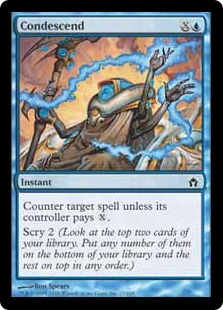
Wizards hasn’t been very generous with Modern-era countermagic. Interacting with spells on the stack is still such a powerful ability that cards like Mana Leak and Deprive end up Modern staples anyway. I’ve always wondered why Condescend sees little play outside of Blue Tron and, occasionally, the nearly-extinct UWR Control.
Given the format’s blistering speed, Modern countermagic needs to address low-curve threats as early as the second turn. The best spells for the job, Mana Leak and Spell Snare, do less in the later game, and the decks that want counterspells are often designed to end up in that stage. Condescend bridges the gap between Remand and Cryptic Command, offering a hard “no” at any stage in the game and backing it up with library manipulation (which, in a topdeck war or a combo deck, is often even better than a cantrip).
As far as I can tell, Condescend best meshes with URx Twin, a deck that gains a lot from soft permission since it can “just win” as early as the fourth turn. Twin also has no reservations about entering the late game, and unlike Mana Leak, Condescend continues to counter spells as players make their land drops. Finally, scry is right at home in a deck that runs a playset of Serum Visions to assemble a combo or find silver bullets. Twin often leaves two lands up on turn two, but only sometimes has the Remand; adding Condescend gives the deck another two-mana play and makes it even harder for opponents to tap out. Additionally, any time gained from opponents playing around Exarch-Twin or Condescend only makes the counterspell better, since it improves with every land drop.
Fits into:
- Most blue midrange and control decks.
- All blue combo decks that operate on a higher curve (3-4 CC spells).
5. Mana Tithe
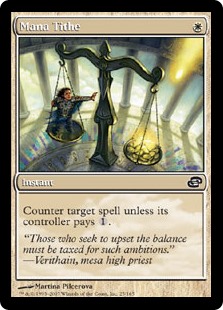
Here’s a card nobody ever sees coming – and that’s what makes it potent. Mana Tithe brings its A-game as a one-off that often gets put in the sideboard once opponents have seen it. The opponent is then forced into a guessing game: play around Tithe the rest of the match or have their spells countered. Usually Tithe is worth running just to “get” that on-curve bomb. More than possibly any other format, Modern rewards players for casting spells on-curve: turn three Exarch, turn four Twin; turn three Liliana, turn four Rhino; turn two Plating, turn three Champion. Mana Tithe gives even non-blue decks ways to interact with the stack in a meaningful way against opponents doing what they must to win the game: playing on curve.
Fits into:
- Decks that can employ or make use of soft permission effects and run white (Jeskai tempo, Mardu midrange, Hatebears decks).
- Nonblue midrange decks as a catch-all against high-curve combo (i.e. Abzan against Twin or Ad Nauseam).
Brew of the Month
I actually don’t know how often I’ll publish brews at the ends of my articles, but here’s a fun one I’ve been working on for some time. Grisly Vial wants to spend its mana on Grisly Salvage, Life from the Loam, Lingering Souls, and activating utility lands, while Aether Vial puts above-curve creatures into play. Tarmogoyf grows to 8/9 post-board, but if you prefer cute interactions to boring beaters, the deck also runs the Haakon-Inversion combo and a Grim Harvest engine to turn dying Spirit tokens into big green guys. Salvage helps find hosers from the sideboard to slow down midrange and combo while attacking opposing life totals.
Grisly Vial, by Jordan Boisvert
Modern leaves players with plenty of cards and options to explore. I look forward to hearing about your favorites in the comments below.






Another sleeper i think is knight of the reliquary. It sees play in some naya CoCo deck but no decks truly takes advantage of the possibility she offers. Here a deck i’m working on with grisly salvage and knight:
lands : 22
4 verdant catacombs
4 windswept heath
2 marsh flats
2 godless shrine
1 overgrown tomb
1 temple garden
2 forest
1 swamp
1 plains
1 vault of the archangel
1 stirring wildwood
2 ghost quarter
Instants : 11
4 path to exile
4 grisly salvage
1 darkblast
2 abrupt decay
creatures : 16
4 steppe lynx
2 scavenging ooze
4 voice of resurgence
4 knight of the reliquary
2 aven mindcensor
sorceries :11
4 raven’s crime
3 life from the loam
4 lingering souls
Thoughts?
I also think Knight is seriously underplayed in this format, especially now with Path to Exile on such a sharp decline. I don’t like Steppe Lynx in this deck since it seems you’d rather go long than put up early aggression, especially without Bolts or even Rhinos to close out the game with reach. Salvage might fit better into a traditional Abzan list, where it turbo-charges Tarmogoyf, feeds Ooze, throws Souls in the grave, accelerates Tasigur, and finds Siege Rhino or lands all at once. In this deck, though, I think 4 Crimes are definitely too many, and would like a Sejiri Steppe to instant-speed protect threats with Knight.
Alright thx for the reply, rhinos and targeted discard should probably be here. i’ll keep working on a goyfless build because $$$ but yeah they would be great with salvage.